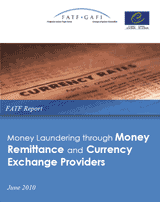This joint FATF/MONEYVAL report contains information on money laundering and terrorist financing methodologies associated with the money remittance and currency exchange sector.
Though the focus of the report is to a certain degree on the MONEYVAL region and the wider European area, the experience of countries from other regions of the world was actively sought and integrated into the report.
Apart from providing a useful general overview of the sector of money transfer remittances and currency exchange providers, the regulatory framework, the supervision and sanctioning regimes, the report sets out identified money laundering and terrorist financing methods and techniques involving money remittance and currency exchange providers.
Several case studies described in this report illustrate that money remittance and currency exchange businesses have been both witting and unwitting participants in laundering activities, in all three stages of the process (placement, layering and integration), and in certain instances, for terrorist financing purposes. The identified risks of ML/TF through the sector detailed in the report are related to clients, owners or agents.
The cases highlight also the links between money laundering in the money remittance sector and other criminal activities (e.g., fraud, trafficking in human beings, smuggling, drug trafficking, economic crime).
A number of vulnerabilities to money laundering across the sector that make up the money remittance and currency exchange sector were identified.
Clearly, laundering through money remittance and currency exchange providers poses a number of regulatory and enforcement challenges. At the same time, it was observed that there is low detection of money laundering in comparison to the size of the industry as a whole. The money laundering and terrorist financing threat in the sector not only results from direct penetration of criminals into operations of money remittance or currency exchange providers. The absence or lax implementation of AML/CFT standards and adequate related policies provide opportunities which are being exploited by money launderers and other criminals.
Finally, the report maps also a number of issues and areas which were identified in this context as appearing to require additional efforts, both from regulatory and supervisory authorities as well as from the industry, in order to reduce the misuse of the sector and ensure that ML/TF risks are adequately addressed.
For more information about this report, please contact the FATF Secretariat at :contact@fatf-gafi.org, or the MONEYVAL Secretariat at: dghl.moneyval@coe.int.


 Twitter
Twitter
 Facebook
Facebook
 Instagram
Instagram
 Linkedin
Linkedin
